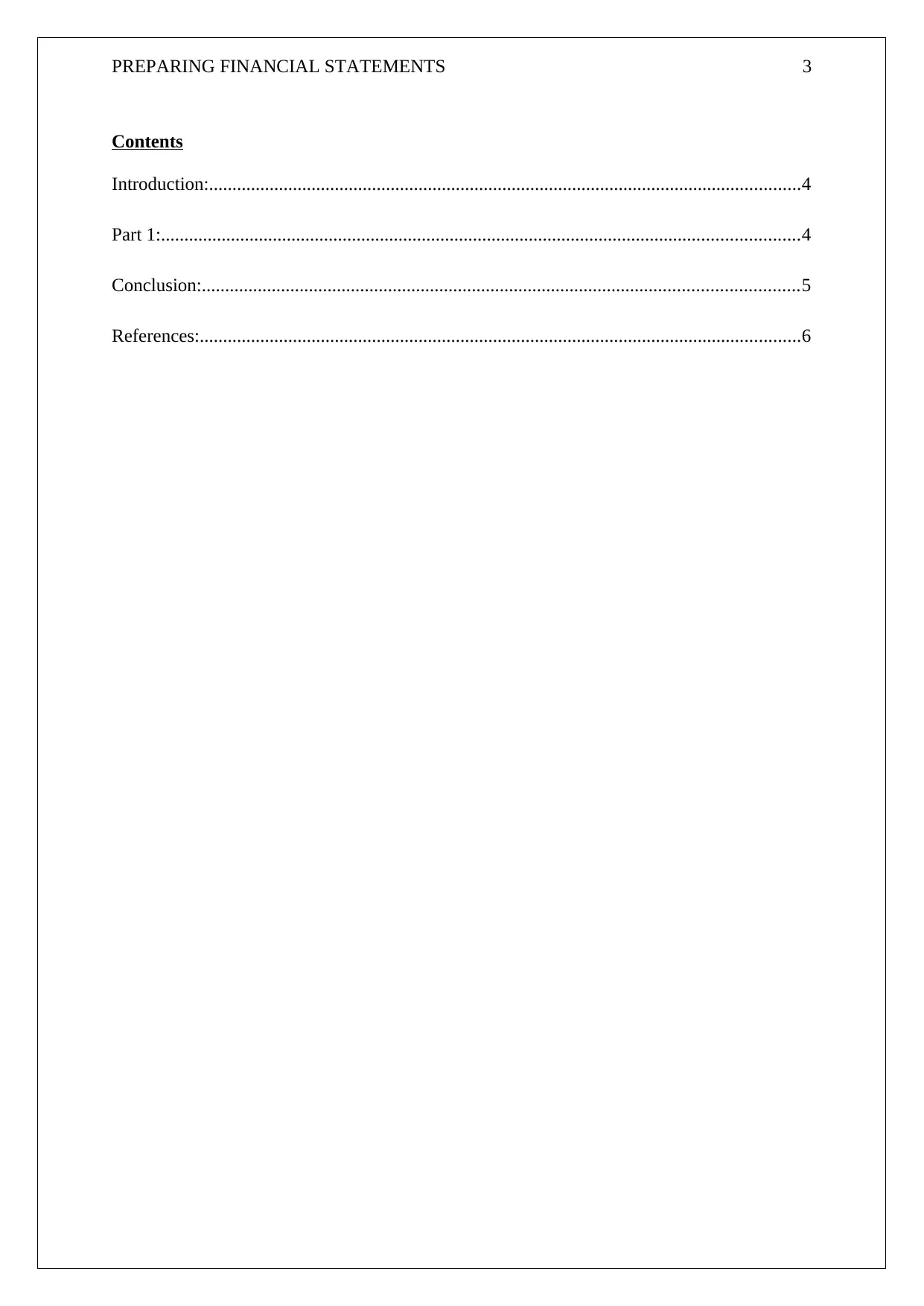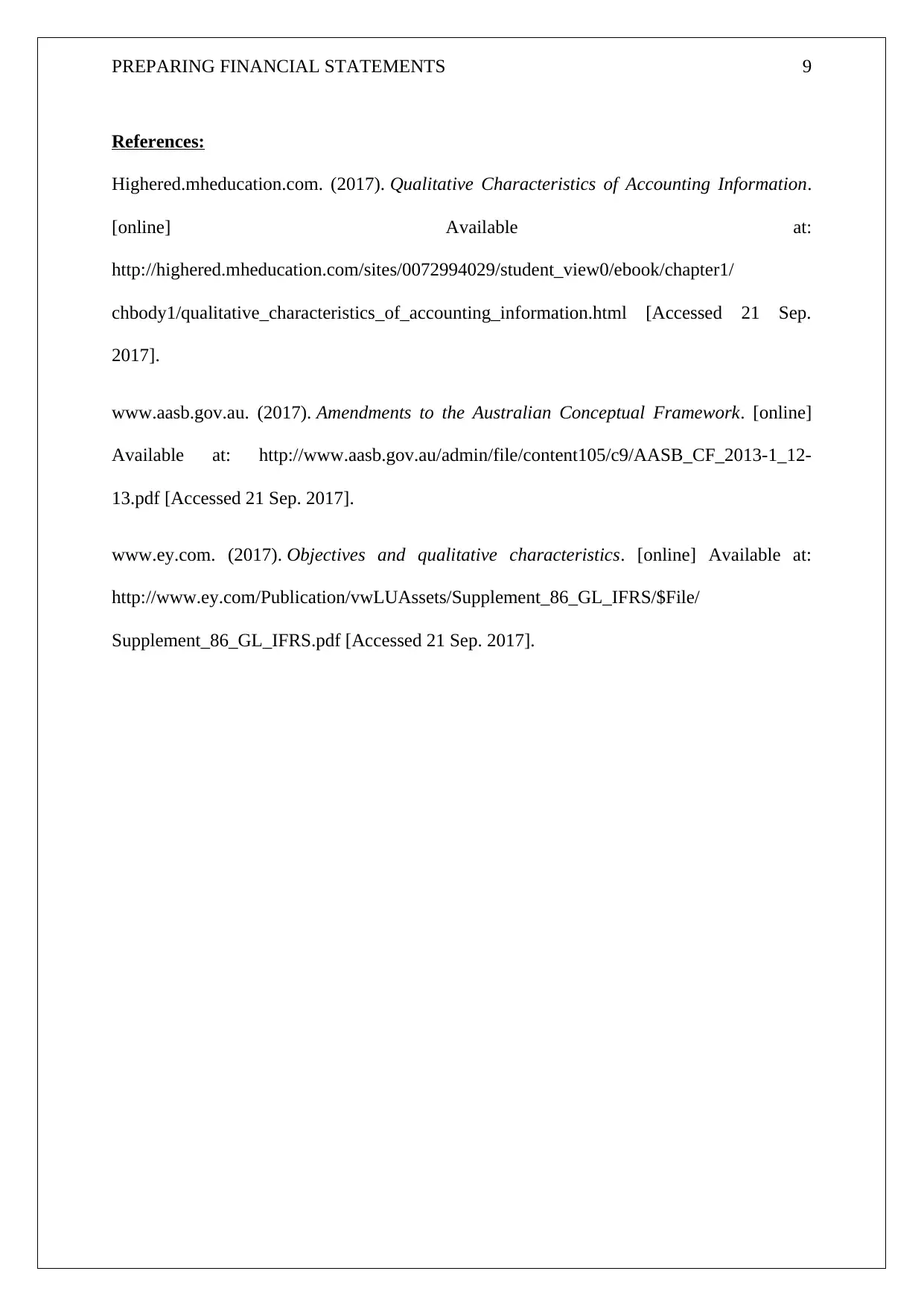Analysis of Financial Statements: Preparation and Characteristics
VerifiedAdded on 2019/11/12
|9
|1478
|145
Report
AI Summary
This report provides an overview of financial statement preparation, emphasizing the importance of these statements for investors, lenders, and other creditors in making informed decisions. It delves into the qualitative characteristics of accounting information, including relevance, reliability, timeliness, representational faithfulness, comparability, and consistency. The report explains how these characteristics impact the usefulness of financial information and guides the preparation process. It also touches upon the role of accounting standards and the challenges of balancing relevance and reliability. The conclusion summarizes the key characteristics, highlighting the importance of providing consistent and comparable information to aid in decision-making.

PREPARING FINANCIAL STATEMENTS 1
PREPARING FINANCIAL STATEMENTS
PREPARING FINANCIAL STATEMENTS
Paraphrase This Document
Need a fresh take? Get an instant paraphrase of this document with our AI Paraphraser

PREPARING FINANCIAL STATEMENTS 2
Abstract:
The financial statements are prepared for the users so that they are able to make the decisions
whether to lend money to the company or to make an investment in the same or not. But
these financial statements are prepared by the management of the company. And so, certain
rules have to be followed when repairing these financial statements like consistency, faithful
representation, comparability etc.
Abstract:
The financial statements are prepared for the users so that they are able to make the decisions
whether to lend money to the company or to make an investment in the same or not. But
these financial statements are prepared by the management of the company. And so, certain
rules have to be followed when repairing these financial statements like consistency, faithful
representation, comparability etc.

PREPARING FINANCIAL STATEMENTS 3
Contents
Introduction:...............................................................................................................................4
Part 1:.........................................................................................................................................4
Conclusion:................................................................................................................................5
References:.................................................................................................................................6
Contents
Introduction:...............................................................................................................................4
Part 1:.........................................................................................................................................4
Conclusion:................................................................................................................................5
References:.................................................................................................................................6
⊘ This is a preview!⊘
Do you want full access?
Subscribe today to unlock all pages.

Trusted by 1+ million students worldwide

PREPARING FINANCIAL STATEMENTS 4
Introduction:
The main aim of the financial statements is to provide the information which is about the
reporting entity and is also useful for the existing and the potential investors, lenders and
other such creditors since that helps them in making decision which are useful for them. The
financial statements also provide in the resources to the entity. These are the decisions which
involve the purchase or sale of the shares, holding of the equity and debt instruments and also
provides in the settling of loans and other such forms of credit (AASB, 2017).
Part 1:
The main qualitative characteristics about the accounting information include the concept of
relevance and reliability. These are very much reliable since in case, this data and the
information is not useful, then the stated information would not be useful. Also, in case this
information is of a little value, even then the same cannot be relied upon.
Relevance: in order to make the decisions, the information contained must possess in the
predictive value and the feedback value. The information must contain both of these qualities.
In order to illustrate, in case the net income along with what is composed of meets the
expectations of the investors about the ability of the company to generate in the future cash
flows, then this net income would have a positive feedback from the investors. This
information is useful when it comes to the predicting of ability of the company to predict the
future earnings.
Timeliness: this is also an important thing which has to be kept in mind. In case, the
information is provided after the decision has already been made, then that information is
useless. The information is required before the decision made and not faster the same has
been made. The information is considered to be timely when the same is available for the
Introduction:
The main aim of the financial statements is to provide the information which is about the
reporting entity and is also useful for the existing and the potential investors, lenders and
other such creditors since that helps them in making decision which are useful for them. The
financial statements also provide in the resources to the entity. These are the decisions which
involve the purchase or sale of the shares, holding of the equity and debt instruments and also
provides in the settling of loans and other such forms of credit (AASB, 2017).
Part 1:
The main qualitative characteristics about the accounting information include the concept of
relevance and reliability. These are very much reliable since in case, this data and the
information is not useful, then the stated information would not be useful. Also, in case this
information is of a little value, even then the same cannot be relied upon.
Relevance: in order to make the decisions, the information contained must possess in the
predictive value and the feedback value. The information must contain both of these qualities.
In order to illustrate, in case the net income along with what is composed of meets the
expectations of the investors about the ability of the company to generate in the future cash
flows, then this net income would have a positive feedback from the investors. This
information is useful when it comes to the predicting of ability of the company to predict the
future earnings.
Timeliness: this is also an important thing which has to be kept in mind. In case, the
information is provided after the decision has already been made, then that information is
useless. The information is required before the decision made and not faster the same has
been made. The information is considered to be timely when the same is available for the
Paraphrase This Document
Need a fresh take? Get an instant paraphrase of this document with our AI Paraphraser

PREPARING FINANCIAL STATEMENTS 5
users so that he could use the same in the process of decision making. The need for the
availability of this information on time is of an utmost importance since that would equip the
users of those financial statements with information and that too on periodic basis. The SEC
requires in the registrants t submit in the financial statements on an annual basis also, on
quarterly and also for the first three quarters for each year.
Reliability: the information contained in the financial statements must be capable of being
verified and also be faithfully represented and neutral. The term verified means different for
different people. In order to illustrate, when an asset is reported in the financial statement,
then it is reported at the cost at which the same was purchased. Now, this amount can be
verified from the market. The cost can also be traced to the transaction that has occurred in an
exchange which is the purchase of asset. But the market value of that asset would be tough to
verify. The market value could different since the company would obtain an appraisers
valuation in respect of the market value of this asset and hence, the market value for the same
would also be different. Also, their value would be different since the appraisers lay down the
value of the asset as per their past experienced and prejudices and also on the basis of
different assumptions. This would difference and so the market value of the asset. This
measurement is prone to verification that makes it tough for the users to be relied on.
Representational faithfulness: this is the characteristics as per with there must be an
agreement between the measures and the description along with the phenomenon which it
purports to represent. In order to illustrate, there is an inventory which is reported in the
balance sheet under the head of current assets. Now, like inventory is something that the
entity holds and represents the items that are used for sales in the ordinary course of the
business. If this inventory which contains the items meant for sale in the ordinary course of
users so that he could use the same in the process of decision making. The need for the
availability of this information on time is of an utmost importance since that would equip the
users of those financial statements with information and that too on periodic basis. The SEC
requires in the registrants t submit in the financial statements on an annual basis also, on
quarterly and also for the first three quarters for each year.
Reliability: the information contained in the financial statements must be capable of being
verified and also be faithfully represented and neutral. The term verified means different for
different people. In order to illustrate, when an asset is reported in the financial statement,
then it is reported at the cost at which the same was purchased. Now, this amount can be
verified from the market. The cost can also be traced to the transaction that has occurred in an
exchange which is the purchase of asset. But the market value of that asset would be tough to
verify. The market value could different since the company would obtain an appraisers
valuation in respect of the market value of this asset and hence, the market value for the same
would also be different. Also, their value would be different since the appraisers lay down the
value of the asset as per their past experienced and prejudices and also on the basis of
different assumptions. This would difference and so the market value of the asset. This
measurement is prone to verification that makes it tough for the users to be relied on.
Representational faithfulness: this is the characteristics as per with there must be an
agreement between the measures and the description along with the phenomenon which it
purports to represent. In order to illustrate, there is an inventory which is reported in the
balance sheet under the head of current assets. Now, like inventory is something that the
entity holds and represents the items that are used for sales in the ordinary course of the
business. If this inventory which contains the items meant for sale in the ordinary course of

PREPARING FINANCIAL STATEMENTS 6
the business include machinery or other such assets, then that would lack in the
representational faithfulness.
There are certain rules in accounting as per which the accounting information is reported in
the books of accounts.
Many of the years ago, the accountants used to use the term reserve for the doubtful debts
which described in the projected in the amount of the bad debts related with the accounts
receivables.
Reserve is the amount which has been kept apart from the amounts of the profits that have
been earned by the company during the year. This amount is kept aside by the company so as
to meet any future uncertainties.
Reliability: this means that the financial statements are reliable and they have been prepared
on some reasonable grounds. The concept of neutrality is very much related with the
establishment of the accounting standards. The changes in these accounting standards would
create in the adverse economic consequences for the companies, their investors and the
creditors along with the other group of the interest. The accounting standards goes on to
establish the overall societal goals and the specific aims and hence, must not try to favour in
the different groups and the companies.
The FASB makes it quite difficult when it comes to neutrality and the consideration of the
economic consequences. The new accounting standards would favour one of companies wen
tit would not favour the others. Hence, the FASB will have to convince in the financial
community which is the result of the standard and the objective would be used to set in the
standard. One of the members of the group stated that the concept of neutrality is of an
utmost importance in the process of setting in the standards.
the business include machinery or other such assets, then that would lack in the
representational faithfulness.
There are certain rules in accounting as per which the accounting information is reported in
the books of accounts.
Many of the years ago, the accountants used to use the term reserve for the doubtful debts
which described in the projected in the amount of the bad debts related with the accounts
receivables.
Reserve is the amount which has been kept apart from the amounts of the profits that have
been earned by the company during the year. This amount is kept aside by the company so as
to meet any future uncertainties.
Reliability: this means that the financial statements are reliable and they have been prepared
on some reasonable grounds. The concept of neutrality is very much related with the
establishment of the accounting standards. The changes in these accounting standards would
create in the adverse economic consequences for the companies, their investors and the
creditors along with the other group of the interest. The accounting standards goes on to
establish the overall societal goals and the specific aims and hence, must not try to favour in
the different groups and the companies.
The FASB makes it quite difficult when it comes to neutrality and the consideration of the
economic consequences. The new accounting standards would favour one of companies wen
tit would not favour the others. Hence, the FASB will have to convince in the financial
community which is the result of the standard and the objective would be used to set in the
standard. One of the members of the group stated that the concept of neutrality is of an
utmost importance in the process of setting in the standards.
⊘ This is a preview!⊘
Do you want full access?
Subscribe today to unlock all pages.

Trusted by 1+ million students worldwide

PREPARING FINANCIAL STATEMENTS 7
The qualities of the relevance and the reliability are completely opposite. The net income
which is forecasted by the employees of the company must have and possess a higher degree
of relevance for the investors. This is also required by the creditors since they have to know
the viability of giving loans and advances of the company.
This forecast contains in the subjectivity when it comes to the estimation of the future events.
US GAAP does to require in the companies to forecast the financial variables.
Then there are other characteristics against the usefulness of the information. They are
comparability and consistency. The term comparability refers to the ability of the users of the
financial information to undersee the similarities and the usefulness of the differences that
exists between the events and the conditions.
Consistency refers to the fact that the same accounting principles are followed for preparing
the financial statements (Higher education, 2017).
Conclusion:
In the nutshell, the financial statements have the following qualitative characteristics:
The information provided must be able to help the decision maker in the process of
decision making
He information must be capable of being verified, facts and be neutral
It must be able to be compared with the information amongst the different entities
The information must be presented from one year to another (Ernst and Young, 2017).
Also, this information contained in the financial statements must be consistent with the
previous years and also, be comparable.
The qualities of the relevance and the reliability are completely opposite. The net income
which is forecasted by the employees of the company must have and possess a higher degree
of relevance for the investors. This is also required by the creditors since they have to know
the viability of giving loans and advances of the company.
This forecast contains in the subjectivity when it comes to the estimation of the future events.
US GAAP does to require in the companies to forecast the financial variables.
Then there are other characteristics against the usefulness of the information. They are
comparability and consistency. The term comparability refers to the ability of the users of the
financial information to undersee the similarities and the usefulness of the differences that
exists between the events and the conditions.
Consistency refers to the fact that the same accounting principles are followed for preparing
the financial statements (Higher education, 2017).
Conclusion:
In the nutshell, the financial statements have the following qualitative characteristics:
The information provided must be able to help the decision maker in the process of
decision making
He information must be capable of being verified, facts and be neutral
It must be able to be compared with the information amongst the different entities
The information must be presented from one year to another (Ernst and Young, 2017).
Also, this information contained in the financial statements must be consistent with the
previous years and also, be comparable.
Paraphrase This Document
Need a fresh take? Get an instant paraphrase of this document with our AI Paraphraser

PREPARING FINANCIAL STATEMENTS 8

PREPARING FINANCIAL STATEMENTS 9
References:
Highered.mheducation.com. (2017). Qualitative Characteristics of Accounting Information.
[online] Available at:
http://highered.mheducation.com/sites/0072994029/student_view0/ebook/chapter1/
chbody1/qualitative_characteristics_of_accounting_information.html [Accessed 21 Sep.
2017].
www.aasb.gov.au. (2017). Amendments to the Australian Conceptual Framework. [online]
Available at: http://www.aasb.gov.au/admin/file/content105/c9/AASB_CF_2013-1_12-
13.pdf [Accessed 21 Sep. 2017].
www.ey.com. (2017). Objectives and qualitative characteristics. [online] Available at:
http://www.ey.com/Publication/vwLUAssets/Supplement_86_GL_IFRS/$File/
Supplement_86_GL_IFRS.pdf [Accessed 21 Sep. 2017].
References:
Highered.mheducation.com. (2017). Qualitative Characteristics of Accounting Information.
[online] Available at:
http://highered.mheducation.com/sites/0072994029/student_view0/ebook/chapter1/
chbody1/qualitative_characteristics_of_accounting_information.html [Accessed 21 Sep.
2017].
www.aasb.gov.au. (2017). Amendments to the Australian Conceptual Framework. [online]
Available at: http://www.aasb.gov.au/admin/file/content105/c9/AASB_CF_2013-1_12-
13.pdf [Accessed 21 Sep. 2017].
www.ey.com. (2017). Objectives and qualitative characteristics. [online] Available at:
http://www.ey.com/Publication/vwLUAssets/Supplement_86_GL_IFRS/$File/
Supplement_86_GL_IFRS.pdf [Accessed 21 Sep. 2017].
⊘ This is a preview!⊘
Do you want full access?
Subscribe today to unlock all pages.

Trusted by 1+ million students worldwide
1 out of 9
Related Documents
Your All-in-One AI-Powered Toolkit for Academic Success.
+13062052269
info@desklib.com
Available 24*7 on WhatsApp / Email
![[object Object]](/_next/static/media/star-bottom.7253800d.svg)
Unlock your academic potential
Copyright © 2020–2025 A2Z Services. All Rights Reserved. Developed and managed by ZUCOL.




